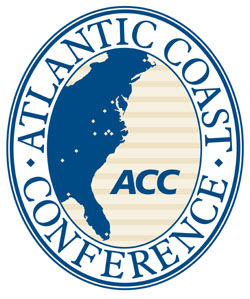The ACC is the most tradition-rich, competitive basketball conference in the
country. It is to college basketball what the SEC is to college football. All
the teams are good, and anyone is capable of knocking off anyone on any given
night. However, will that type of parity come back to bite the ACC in the
postseason?
There are six power conferences in the college basketball: the ACC, Big East,
Big 12, Big Ten, Pac-10 and SEC. All have teams that are on the bubble, and you
can make an argument for or against any of them. One of the things you can look
at is the strength of the conference they play in.
The following table compares each power conference in the RPI, and how many
teams in each rank high, low, or middle of the pack in the RPI.
Conference RPI Stats |
||||||
Conference |
1-25 |
26-50 |
51-100 |
101-150 |
151-200 |
201+ |
ACC |
4 |
0 |
6 |
2 |
0 |
0 |
Big 12 |
2 |
5 |
0 |
2 |
2 |
0 |
Big East |
6 |
1 |
4 |
2 |
2 |
1 |
Big Ten |
3 |
1 |
2 |
1 |
3 |
1 |
Pac-10 |
3 |
2 |
3 |
1 |
0 |
1 |
SEC |
2 |
4 |
1 |
3 |
2 |
0 |
Although the ACC has the fewest Top 50 teams, a higher percentage of its teams
rank in the Top 100 than any other conference. The two teams that are outside of
the top 100, Boston College and UVA, are close, ranking 111 and 113
respectively.
That’s a pretty even league, from top to bottom, and the ACC is the only
power conference in the nation that doesn’t have a team ranked 150 or lower in
the RPI. ACC teams beat each other up, every single night. Although that’s held
a couple of teams back from getting up into that Top 50 this year, it has
created a very balanced league where there are no bad losses.
The ACC also has the best average RPI in the nation.
Top Conferences |
|
Conference |
Ave. RPI |
ACC |
59.92 |
Big 12 |
68.33 |
Pac 10 |
69.8 |
Big East |
75.44 |
SEC |
81.67 |
Big Ten |
99.36 |
Not only does the ACC have the top RPI in the country, it isn’t particularly
close. They are the only conference to have an average ranking better than 60.
The Big 12 and Pac-10 are right behind, basically in a dead heat. They are
followed by the Big East and SEC.
The Big Ten is easily the worst power conference in college basketball, with
an average RPI barely better than 100. That’s despite placing three teams in the
top 20, with one more in the top 35. The Big Ten has five teams ranked 136 or
lower, and five total teams with losing records. Five out of 11! Two of those
teams haven’t even won 10 games this season. One of those teams, Northwestern,
recently won their first conference game of the year.
There are a lot of easy wins in the Big Ten. Four teams (Wisconsin, Michigan
State, Indiana and Purdue) are definitely in the NCAA tournament. Another (Ohio
State) might end up there. Four teams is fine, but the worst power conference in
the nation shouldn’t have more bids than the ACC. It’s possible that the ACC
will only have four bids. When you consider the strength of each league, the ACC
should have more teams, certainly not less.
Those five schools that rank at the bottom of the Big Ten in the RPI aren’t
even close in the standings to UVA, the ACC’s lowest-ranked team. Minnesota,
right in the middle of the Big Ten standings at #91 in the RPI, would rank third
from the bottom in the ACC.
Of course, every conference has a couple of bottom feeders that drag the
conference down. What would happen if we took out those teams? Let’s find out.
We took out the two worst teams from the 12-team conferences and the Big Ten,
three teams from the 16-team Big East, and just one team from the Pac-10. Here
is what those numbers look like…
Top Conferences (bottom-feeders removed) |
|
Conference |
Ave. RPI |
Pac-10 |
48.89 |
ACC |
49.5 |
Big 12 |
49.9 |
Big East |
50.2 |
SEC |
66.7 |
Big Ten |
76.56 |
Taking away Oregon State, who is #258 overall and winless in conference play,
gives the Pac-10 a huge boost, shooting them all the way up to first place. In
fact, the first four conferences, the Pac-10, the ACC and the Big 12, are
basically even. The SEC lags behind those four, and even with #183 Iowa and #221
Northwestern eliminated, the Big Ten is still in last place by a mile.
What does all that mean? To me, it means that the talent amongst the better
teams from those top four conferences is fairly even. All 10 of the ACC teams
included in this average are ranked in the Top 100. All eight of the Pac-10
teams are in the Top 100. The Big East still has three teams outside the Top
100, but a lot of highly ranked teams make up for it.
 The
The
ACC is the only power conference with no true "bad" teams. ACC teams
on the bubble, like Virginia Tech and Maryland, don’t have any gimmie games to
pad their schedule, like teams from some conferences — unless you count
Virginia and Boston College, but when you consider that those teams have Top 30
wins against Arizona and Miami, as well as other wins against Top 100 NC State,
Georgia Tech, Rhode Island, Maryland, etc., it’s hard to view those teams as
easy wins. They are quality basketball teams.
I think the Pac-10 is probably the best conference this year, while the ACC
is the most balanced. The Big East has a lot of good teams, but plenty of bad
ones; same for the SEC and Big Ten. The Big 12 is sort of the happy medium. Good
balance, but a couple of bottom feeders as well.
When it comes time for the NCAA Selection Committee to make their picks
however, none of that is going to matter much. They will look at each team
individually. They’ll look at overall record, conference record, RPI, Top 50
wins, etc. Rightly or wrongly, what conference each team plays in probably won’t
have much of an effect.
At this point, opinions are mixed on whether or not the Hokies will get in. The
Bracket Matrix keeps track of 56 different projected brackets across the
internet. Right now, the Hokies are in the field in 27 of those 56 brackets,
nearly half. They range anywhere from an 11 seed to a 13 seed. It seems like
they’ve got a 50/50 shot at this point.
What I don’t like is that Maryland appears on 39 of the 56 brackets. The
Hokies have a better overall winning percentage, a better conference record, a
higher RPI, and they beat the Terps head to head on two occasions. How in the
world can Maryland be in more brackets than the Hokies? The answer is the Terps
won at North Carolina, while the Hokies were pounded by 39 points in Chapel
Hill. Maryland is in 12 more brackets than Tech because they got lucky and UNC
decided not to stomp them into the mud.
We’ll see what happens after another weekend of games and the conference
tournaments, but as Jimmy Dykes said on ESPN2 last night, if you’re on the
bubble, "just keep winning."












Tech Sideline is Presented By: